Toronto International Film Festival 2012—Part 5
Detroit’s belated “renaissance”—on film
By Joanne Laurier
5 October 2012
This is the fifth of a series of articles devoted to the recent Toronto film festival (September 6-16). Part 1 was posted September 22, Part 2 September 26, Part 3 September 28 and Part 4 October 2.
In recent years we have commented numerous times in articles on the WSWS and other forums about the extraordinary weakness of the US filmmakers’ treatment of American life. So little of this reality and its texture has appeared on movie screens in the last couple of decades.
Particularly disgraceful has been the absence of any serious artistic examination of the ravaging of what was once one of the world’s leading industrial centers, Detroit. (Curtis Hanson’s 8 Mile [2002] was no such effort, by any objective standard ). An honest look would demolish the obscene official claims about the city and its auto industry “roaring back.”
As it turns out, contrary to those who assure us that art and everyday life exist in two distinct realms, external and indifferent to each other, social developments are pressing through the “dark shell of the [artists’] subconscious.”
In other words, a number of films about Detroit have suddenly emerged—first and foremost, documentaries. One is Detropia, which we will review on the WSWS. Another is Burn: One Year on the Front Lines of the Battle to Save Detroit. Detroit also has an important presence in Far From Afghanistan, in which director Travis Wilkerson introduces material on utility shutoffs and the social disaster in the city.
And now a fictional treatment has appeared. But the present is always a surprise. So the first fiction work that attempts to deal with life in Detroit is … a comedy about Arab Americans!
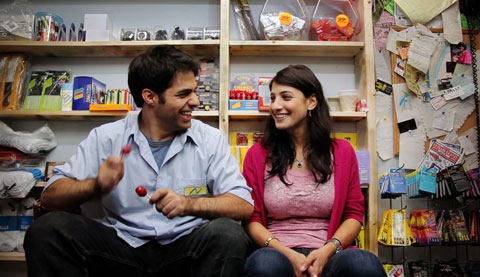 Detroit Unleaded
Detroit UnleadedWhile Detroit Unleaded, by debut writer-director Rola Nashef, is not a head-on social critique, it is a warmhearted piece about the complicated interactions between the city’s Arab and African American populations. In the course of often humorous encounters, something of the devastation of the city is captured. Although Detroit’s crisis principally plays the part of the elephant in the room in the movie, it nonetheless inevitably forces its way into the drama and imagery.
The essential sweetness of Nashef’s film lies in the basic solidarity of its multi-ethnic working class characters who come together in and around an inner-city gas station. Camaraderie flourishes in the midst of the ruins. In individual situations where poverty is not the most pressing issue, there is still the psychological impact of a social cul-de-sac.
The movie opens, in a sort of prologue, when gas prices stand at $1.93 a gallon. A Lebanese-American gas station owner is fatally and tragically shot during a robbery, and the open-24-hours-a-day enterprise is passed on to his son Sami (E.J. Assi). The latter’s dream of going away to college is crushed. He is his grieving mother’s loving, but somewhat resentful, caretaker.
As Detroit Unleaded’s narrative really gets under way, gas prices now hover at four dollars a gallon and the station has been equipped with a (thick and ugly) protective plexiglass “cage” in which Sami is stuck for long hours servicing a parade of customers whose recurring query is, “When is gas going down?”
To gain a competitive edge in the gas price war with a neighboring station (owned by a relative!), Sami’s fiercely ambitious cousin Mike (Mike Batayeh) proposes to sell an array of merchandise. His scheme is to build an empire, one cheap, tawdry item at a time.
The station’s parking lot is imperiously managed by lovable, dim-witted Roger (Scott Norman), a willing slave to the business. Life is monotonous for Sami until the beautiful Najlah (Nada Shouhayib) appears at the station selling phone cards. Their courtship takes place within the confines of the station’s cramped cage as customers, from “home boys” to older workers getting laid off, pay for their wares through the supposedly bulletproof enclosure. Cousin Mike is disapproving, considering Najlah an “up-do” girl, who, in any case, is on “lock down” by her brother, Fadi (Steven Soro).
The over-protective Fadi indeed presents an obstacle, which his sister seeks to circumvent through the unwitting aid of her nosy, loquacious girlfriends. In one memorably comic scene, Najlah arrives late at night at the gas station with her co-conspirators decked out in skimpy party dresses. (“We’re going to get lost, we’re going to get killed and our parents are going to find us in these clothes.”)
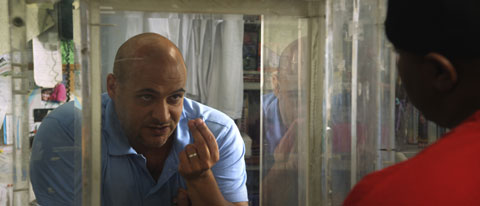 Detroit Unleaded
Detroit UnleadedWhat’s unusual about Detroit Unleaded is that it is not an exercise in either backwardness or gloom. It is lively and amusing, with a talented and effective cast, many of them new to professional acting. Its storyline may be a little too cheery and uplifting, considering the subject matter, but the film is a fluid and pleasing work. Its remarkable comic timing (in both the performances and editing) is a considerable accomplishment for any filmmaker, all the more so for a first-time director.
Director Nashef says in the movie’s production notes: “Detroit is home to one of the largest Arab and African American populations in the States and where I have lived for over fifteen years. It was when I moved here that I first saw bulletproof glass in gas stations. In every neighborhood, I would encounter Arab men behind the glass, their voices muffled and their images distorted. While gas stations made money, I had to ask myself, ‘This is the American Dream?’ I felt that sitting in a gas station, for hours on end, must actually distort your own vision of the world—much more than just physically.”
A conversation with writer-director Rola Nashef
This reviewer spoke to Detroit Unleaded director, Rola Nashef, by telephone.
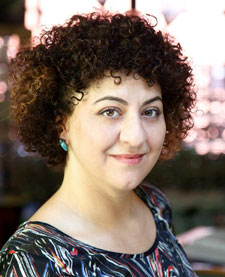 Rola Nashef
Rola NashefRola Nashef: I was born in Lebanon and was raised in Lansing, Michigan, and moved to Detroit years ago right after college. I have a big family tribe in both Lansing and Detroit. I worked at Arab community centers and did a lot of grass roots organizing—social justice work. I found art through this work. It was a powerful experience to make a decision to become a filmmaker, one that I have never second-guessed.
For first-time filmmakers, at least that was the case for me, it’s a long process and a steep learning curve. I put everything I had into the film. For the last five years, from the writing to the production, this was all I thought about. I also had great collaborators in the crew and the cast. I had a community that was around me and the project for years.
I kept thinking what a cool hybrid culture Arab American youth have created in Detroit. At the same time, it’s universal.
Joanne Laurier: The film shows both the particular features of the Arab American community, but also its integration into and impact on Detroit and its residents.
RN: This was an inspiration because I had witnessed this within these gas stations. There is all this horrible imagery about Arabs and African Americans that is promoted by the media—how violent they are. This is how they are portrayed in the news. But I would go into a gas station and see all the friendship there.
I was interested in the relationships that formed despite the glass cages that protected those working in the stations. I always saw in the relationship between the Arab clerk and the African American customers, the Arabic expression that “people are close to your heart,” which means you know them. I felt there was a closeness that was never discussed.
JL: It was to your credit that you had the observational skills to notice all the intense human drama that went on in such everyday locations.
RN: It was the first time that I saw these bigger themes and metaphors played out in this tangible manner. It was like a spark for me. I grew up in Lansing which is very integrated—black, white, Arab, Mexican, Latino, immigrant and non-immigrant, UAW [United Auto Workers union] and government workers all together.
Detroit is more segregated. So when I moved there, I thought, does anybody think this glass cage is weird? I wondered what it did to the clerk who had to interact with the people through this glass—always seeing the world through this lens.
JL: Could you speak about how things have changed for the Arab American community since 9/11?
RN: As an artist, I never start off with what I want a film to convey. That being said, I knew that through the film, people were going to witness a very different Arab America. I knew that if I could get an audience member to go through a journey with someone who happened to be an Arab American, it would a lot harder to stereotype or discriminate against the character, particularly without all the fear factor media frenzy. I wanted to present the real human face, which is the real reality.
JL: In an effort to bring the American population on board its endless wars in the Middle East, successive administrations, both Republican and Democrat, along with the media, have promoted this foul stereotype of Arabs that your film challenges and helps demolish. In addition, your film is one of the few that sheds light on inner-city Detroit.
Can you speak about why the Arab community is so large in the Detroit area?
RN: The auto plants attracted many people from the Middle East, even though there have been Arab immigrants here since the turn of the century. The huge rush came as a result of the Lebanese civil war [1975 to 1990]. After the 1967 riot in Detroit in particular, there was the “white flight” that left many abandoned businesses, especially gas stations.
We pooled our cash as families and tribes, and bought these gas stations, one of which might support some 30 people. I don’t know if this is true, but I heard that there were no 24-hour gas stations before Arab ownership—people now just worked day and night.
JL: Could you speak about the changes you’ve seen in Detroit?
RN: My dad worked as a production worker for General Motors in Lansing. I saw everything first-hand. He was always on the rotation of being laid off and rehired. I saw how disturbing this could be to a family. When I moved to Detroit, I experienced the collapse of the city that happened so quickly.
I think Detroit represents the heart of the country, its industry made the US. But there is something so American about how the city rose up so quickly—and crashed so quickly.
I have always been inspired by the people of Detroit. The way people related to each other here is very different than other parts of the country, like on the East and West Coasts. One hears terrible things about Detroit, that it is a brutal place. So I also wanted to put a human face on a place that I think is very humane. So far, I have never seen an authentic portrayal in cinema of the Detroit population.
The Attack
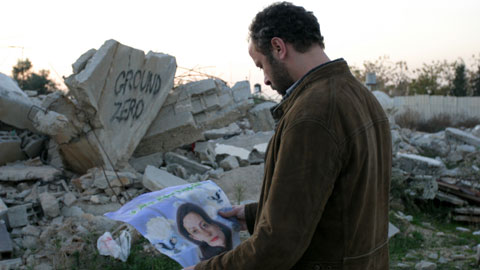 The Attack
The AttackLebanese-born American filmmaker Ziad Doueiri’s film, The Attack, centers on Israeli Palestinian surgeon Amin Jaafari (Ali Suliman), a respected member of Tel Aviv’s professional class. His status is challenged and his contented world shattered when he learns that his wife Sihem (Reymonde Amsellem) is responsible for the suicide bombing of a Tel Aviv restaurant that leaves 19 dead.
Devastated and tormented by the fact he was oblivious to his wife’s clandestine activities, Amin undertakes a dangerous journey to the occupied West Bank in search of an explanation. There he encounters an underground that both celebrates Sihem’s martyrdom and attacks him for his apparent loyalties to Israel. He eventually finds his way to Jenin where he comes face to face with the destruction caused by the Israeli army in 2002. Amin is forced to reevaluate his relationship with his “adopted” country and his Israeli colleagues.
The Attack is a well-done, intelligent work. There are a number of authentic types: one Israeli cop friendly to Amin and another who is a violent thug; a reactionary Islamist sheik and a surprising Christian priest in the Occupied Territories. But the mystery at the center of the film—how and why Sihem becomes a suicide bomber—is never adequately explained, either psychologically or politically, despite (or perhaps because of ) the brief reference to and several images of Jenin’s terrible wreckage.
Furthermore, director Doueiri (West Beirut, 1998) paints Israeli society as rather idyllic and immune from internal, social conflict. Though his film focuses on the country’s upper middle class, Doueiri appears insensitive to the fact that Israel is riven by class antagonisms and the population is increasingly restive. A film that paints the situation in the Middle East as a purely national struggle is surely limited and unsatisfying at this moment in history.
That the movie is based on a 2007 book written by Yasmina Khadra—the pen-name for Mohammed Moulessehoul, a one-time officer in the Algerian army—may explain why The Attack’s intellectual-emotional core seems somewhat passé. Palestinian nationalism is rediscovered by the film’s central characters well after it has played itself out.
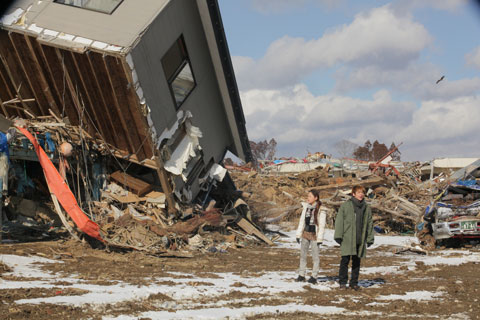 The Land of Hope
The Land of HopeIn The Land of Hope, Japanese director Sono Sion treats the aftermath of the Tohoku earthquake and the resulting nuclear calamity. Unfortunately, it is impossible to separate the movie’s tongue-in-cheek tone and its antics from the serious subject matter, resulting in a very inconsistent work.
There is a positive element here—the film is one of the few produced by the Japanese cinema, socially indifferent and rather inconsequential for the most part in recent years, that attempts to deal with any aspect of the country’s social disaster. In this context, simply the mentioning of the earthquake and nuclear emergency merits credit.
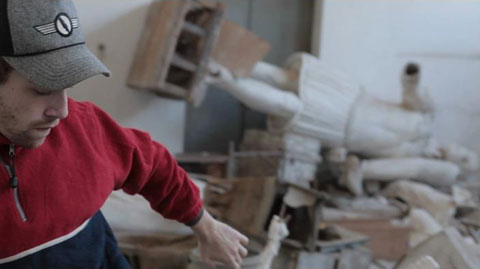 Boy Eating the Bird's Food
Boy Eating the Bird's FoodAn unprecedented social crisis, unhappily, plays an even smaller and more peculiar role in Boy Eating the Bird’s Food by Greek filmmaker Ektoras Lygizos, loosely inspired by Knut Hamsun’s classic 1890 novel Hunger. Lygizos tries to explain the destruction of Greek society at the hands of the European and American banks by the drive of a young, educated man to assuage his physical and emotional hunger in bizarre and anti-social ways.
Writes Lygizos in the movie’s press notes: “It was a way for us to talk about what is happening in Greece where using your own creative strengths is becoming more and more difficult. You end up instead consuming yourself: Eating your own strength [all too graphically illustrated in the movie] in a demeaning effort to feed your soul with anything, since you have nothing.” Fortunately, this is not the general reaction of the Greek working class. Entire populations do not “consume themselves,” they make social revolutions.
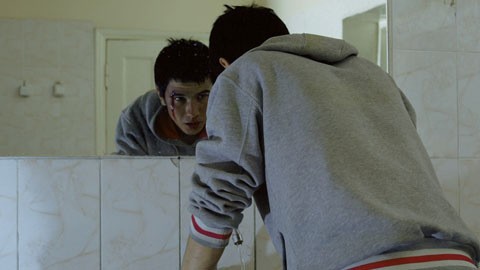 Student
StudentKazakh director Darezhan Omirbayev’s Student is also a loose adaptation of a literary classic, Fyodor Dostoyevsky’s Crime and Punishment (1866), set in present-day Almaty, Kazakhstan’s former capital. The movie’s rambling, dark plot portrays the poverty and alienation that have reached acute levels as a result of the restoration of capitalism and the growth of a nouveau riche mafia elite in the former Soviet territory.
But Omirbayev, who has made some interesting films in the past—Cardiogram, 1995; Killer, 1998—adopts the 19th century novel’s ultimate religious moralizing as the guiding principle for his movie, to an artistically debilitating effect.
To be continued





Follow the WSWS